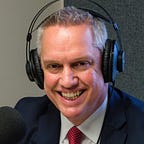The Crossman Conversation
Why Kids Can’t Read and How to Solve the Problem
The global literacy crisis is something we should all be concerned about. One woman’s quest to help her dyslexic son has grown into a worldwide literacy movement.
Jenn Knopf believes that literacy is a fundamental human right, but only about a third of our nation’s kids can read proficiently.
The societal damage caused by illiteracy (including people who can’t read at all and people with limited reading skills) is vast and includes poverty, higher incarceration rates, poor health, and workplace challenges for both employers and employees. Someone should do something, right? Well, Jenn Knopf agrees — and she’s doing it.
Jenn is the founding director of REED (Reading Education Endowment for Dyslexia) Charitable Foundation. When Jenn was my guest on The Crossman Conversation, she opened my eyes to a startling fact:
The way we’re teaching kids to read, write, and spell only works for 34 percent of them.
Jenn’s story is fascinating. Her first child is a 99th-percentile language arts student. Her second child was bright and articulate but couldn’t remember letters and letter sounds. After a painful, frustrating, heartbreaking journey, Reed was diagnosed with dyslexia at the age of six.
Dyslexia is a life-long condition that is often overlooked. I’m dyslexic but wasn’t diagnosed until I was in my 40s, and that discovery explained so much about the challenges I’d faced throughout my life.
As Jenn began researching how to help her son, she learned more than she expected.
“Actually, 66 percent of our nation’s fourth graders do not read at grade level,” she told me. “That gets worse by eighth grade and worse by high school.”
It wasn’t just children with learning differences who were struggling to read. It was the majority of students.
Jenn said we changed the way we teach reading about 30 years to a method that only works for about a third of the kids — and those kids, she said, were “learning despite of us and despite the instruction, not because of it.”
But there’s a solution: Change the way we teach reading.
Jenn discovered a technique called OG (Orton-Gillingham approach) that is considered the gold standard in literacy instruction for all students and vital for students with dyslexia.
She could have just helped her own child, but that wasn’t enough for her. Instead, she established REED Charitable Foundation to empower the dyslexic community and end the global literacy crisis by training teachers around the world to use the OG approach.
“The goal is to train every single teacher so that every single child can read,” she said.
I challenge you to listen to my conversation with Jenn Knopf and not choke up at least once. And I promise you: You’ll want to be a part of this potentially world-changing effort. Here’s the link:
Thanks for reading. Here’s a little more about me:
